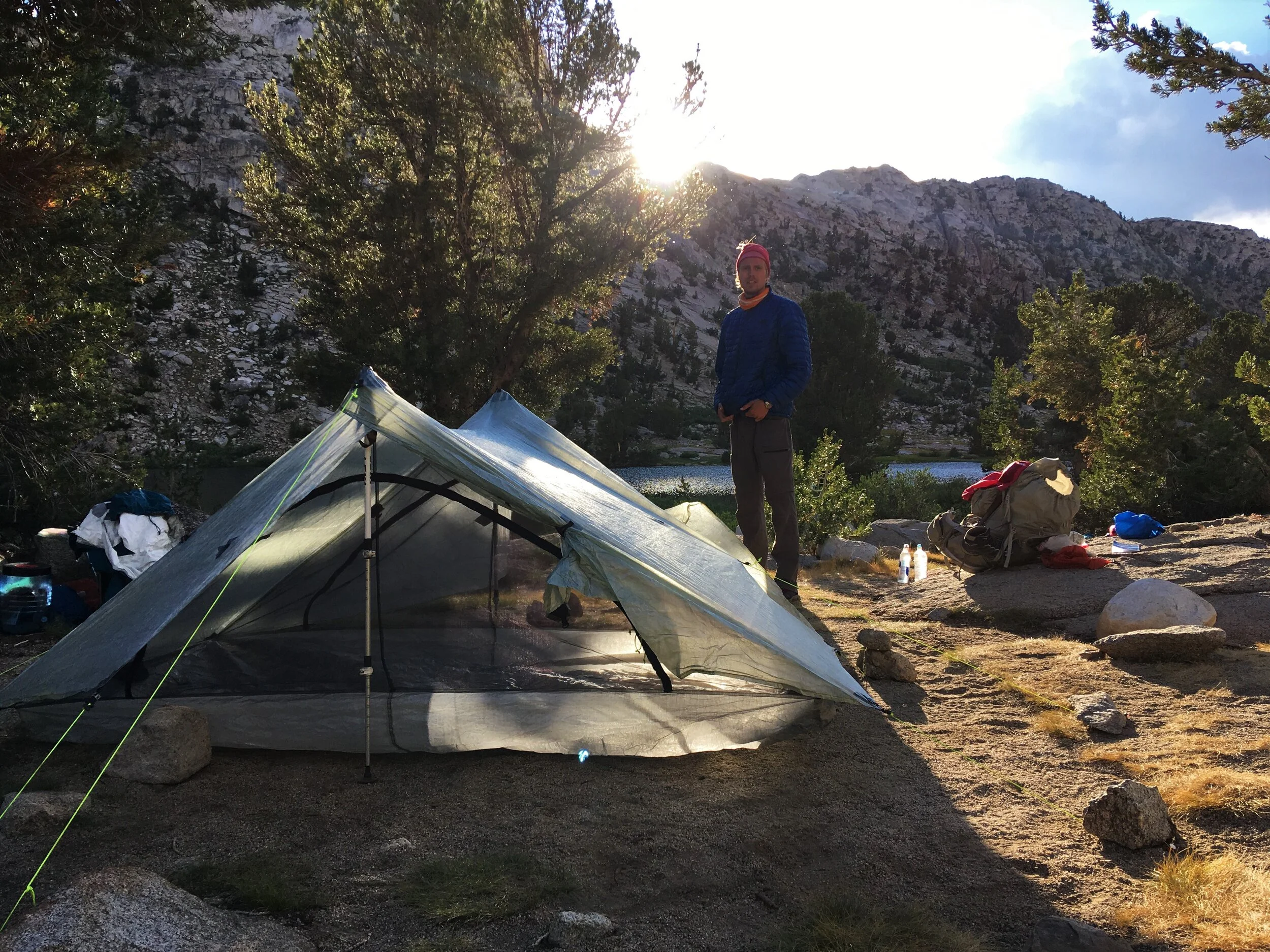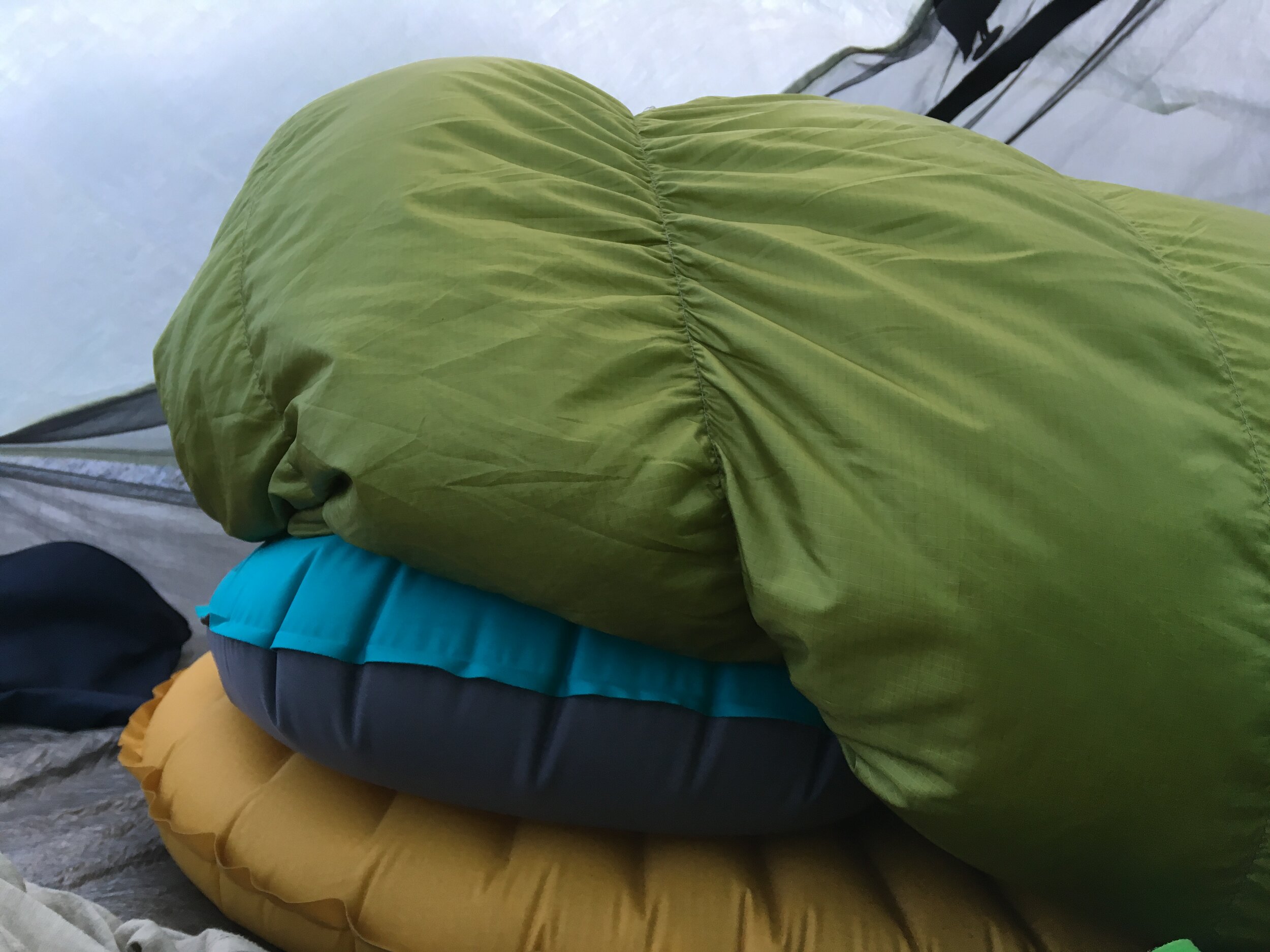This “what to take” series will be split in multiple parts so we can cover everything properly. Here I cover the “Big 3”, aka sleep systems, aka shelter, sleeping bags and sleeping mats.
Funnily enough, regardless of whether you’re just doing a weekend camping trip or a 2000 km thru-hike, you’ll likely be needing the same gear. Of course you carry less food on shorter trips, but you will be using the same stuff pretty much every day. I’ve posted my gear-lists from the John Muir Trail and the GR20, and it might seem like a looooot of stuff for inexperienced backpackers. Not to worry! While trekking gear is a matter of preference, we all take a lot of the same things with us – many items are just necessary. Items that tend to vary the most between hikers are so-called “luxury items”; things you don’t strictly need but would really like. This can be books, journals, inflatable pillows, coffee mugs, lightweight camp chairs, ukuleles… you get the idea. I’m guilty of a couple of these myself, but for now let’s stick to the basic items you’ll need for your trekking adventure!
shelter
A tarptent Double Rainbow, Hilleberg Enan and ZPacks Duplex in the Ahuriri Basin, New Zealand
Hammock: Hiking on the Mongolian steppe or deserts of southern California? A hammock may be a bad choice here as there are no trees. But for a weekend trip in your local forest? Perfect! I’ve never actually hammocked, but my friends will vouch for it, and it’s probably the fastest-growing outdoor trend these days.
Tarps are very lightweight and offer basic protection from rain, but leave you exposed to bugs (which, if you’re in Oregon or Scotland, will leave you anaemic after two nights). They can be set up in a flash in case you would like to wait out some rain, and you can cook beneath it without the fear of an inferno occurring. Ultralight hikers sometimes use tarps, but…
I prefer a tent any day for multi-day hikes. You have endless types to choose from. Double walled tents – the kind your family used on camping trips – are heavier, but cheaper and give much less condensation. If the night is clear, you can also set up only the inner tent and look at the stars. Single-walled tents are significantly lighter and all the rage these days, but come at the cost of increased condensation. Which might not sound so bad, but it can be a real nuisance. Tents can come incredibly lightweight, but they will probably be the most expensive item in your pack. By far.
The answer to freestanding vs. staked is blowing in the wind…
About size: A 2-person tent can fit two people comfortably, however… if you can stomach the added weight, I would recommend getting a tent designed for one more person than your hiking party. This especially applies to 1-person tents, because these tend to be tiny. Like, too small to even fit your gear, and you will lie like a caterpillar in a cocoon trying not to touch the edges for fear of dampening your sleeping bag. I am super happy with my ZPacks Duplex, the lightest two-person tent in the world, which has now become a classic on popular thru-hikes around the world. It’s a single-walled, 2-person tent made of Dyneema, an ultra-durable and waterproof fabric, it ticks in at 550 grams and 600 USD (heeeelp).
Some tents are freestanding, others have stakes. Whatever you choose, make sure you practice setting it up before you hit the trail.
Sleeping bag
The newbie days of cheap, synthetic sleeping bags (look at that bag to pack ratio!)
Bag or quilt? I’ve never tried quilts, but many swear by them as you can save some weight. For a sleeping bag I would highly recommend a mummy bag that traces the shape of your body so that less heat is lost and you can cinch the top snug around your face.
Both quilts and sleeping bags can be either down or synthetic. Down typically packs down smaller and are lighter, but require more upkeep & are more expensive. Their lovely fluff and loftiness traps heat better. Synthetic bags are bulkier, but they can be washed in a washing machine and stay warm even if they get wet. They also don’t last as long as a down bag. If you’re aiming for a soggy trail like the Appalachian Trail, a synthetic bag may be best. However, for drier adventures like the Pacific Crest Trail or the Camino de Santiago, a down bag will do great.
A fluffier down sleeping bag with lots of loft, the Cumulus Lightline 300 is also prone to sogginess
The most important thing about your sleeping bag is that it has the right temperature rating. You want to be well within the comfort temp for the climates you’ll be hiking in. Winter bags can be rated down to -50C, but will be massive. For a typical thru-hike you will need a 2/3-season bag. The comfort temperature indicates the minimum climate you won’t feel the cold in, the “extreme temperature” indicates how cold it can get before you get frostbite or even die of hypothermia. In other words, you should pay attention to these and not just think “but I’m such a warm sleeper” and buy a bag because it feels soft or has a nice colour.
NOTE: Comfort temperature ranges differ for men and women! We all want gender equality, but sleeping bags ain’t it. Women’s bags usually have more padding around the hip and toe box because we tend to lose more heat there. I have a man’s bag that has proven too cold in the High Sierra – the comfort rating is based on a male body with more heat-retaining muscle mass. Sad but true.
sleeping pad
Mummified hiker in three layers of respectively: Thermarest NeoAir XLite pad, SeatoSummit pillow and Cumulus bag
Thank god the days of the closed cell foam pads are over. Those huge and bulky roll-up things we used in the 80s just won’t cut it on a long hike. Your back will die, you will die. To all of you Thermarest ZLite users out there: I’m prepared to go to the grave over this one!
Inflatable pads come in all shapes and sizes, you can now get super lightweight ones that roll up small. The two things you want to think about are 1) comfort – how thick do you want it to be if you have a bad back etc and 2) R value, which is how insulating the pad is from the cold ground. Your pad is actually as important as your sleeping bad for keeping you warm!
I use what is probably the most popular sleeping pad among long-distance hikers: the Thermarest NeoAir XLite. This bright yellow bunkmate is known for being quite noisy – try fondling one in the store and you’ll see what I mean – but provides great comfort for the weight.
The only trouble you’ll have with inflatable pads is, predictably, that they can puncture. This is especially true if you’re sleeping under a tarp with no ground sheet to protect against sharp rocks and twigs. Luckily, most of them come with small repair kits. If you suspect a hole, hold your inflated mat underwater and see if any bubbles arise. I’d highly recommend reading reviews of pads you’re looking to buy online, as some are more fragile than others.
Oh, and just because the pads aren’t recommended as flotation devices in alpine lakes doesn’t mean you can’t give it a try! Some of the best outdoor photos I’ve seen are of hikers tanning Club-Med style on their sleeping pads with granite peaks in the background.
optional extra
Toby in his Tarptent on a Thermarest Neoair XLite
An inflatable pillow like my SeaToSummit takes up no space and weighs nothing. They are not cheap though, so if you are happy to bundle up some clothes to prop under your head as a pillow, go right ahead. For me it’s worth it to carry a pillow because I already sleep quite restlessly in the wild, and I’m happy to not have to readjust the clothes bundle all the time. Pro tip for inflatable pillow: don’t blow it up completely, leave some air for extra cushiness.
Sleeping bag liner: Aah, this is a contested one. I am one of the very few hikers I know who carries a thin silk liner for my sleeping bag. Perhaps it’s a cultural thing, in Norway these are always used at our National Trekking Association cabins and are a staple gear item.
Ultralight hikers will probably ditch them because they aren’t strictly necessary. But they have several perks: on warm nights you can sleep in just the liner with your sleeping bag as a blanket; they add a few degrees of warm to your bag AND they significantly prolong the life of your bag/quilt by keeping it cleaner. Anyone who has ever experienced a surprise period can confirm. Much cheaper to replace a liner than the whole bag.







